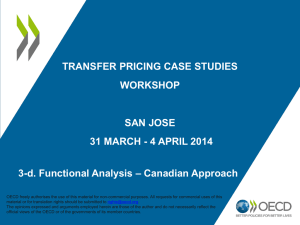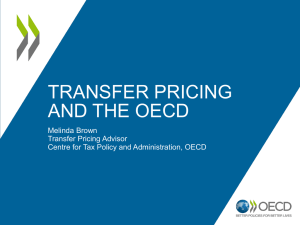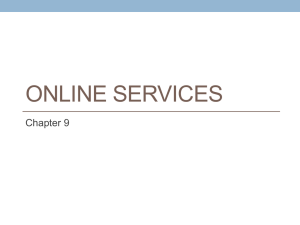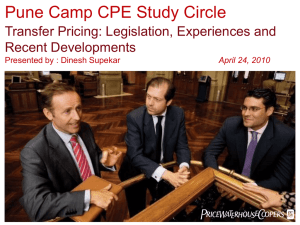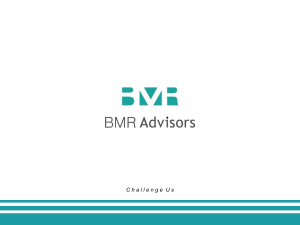A Practical Insight CA.Natwar G Thakrar 27th Oct 2012
advertisement
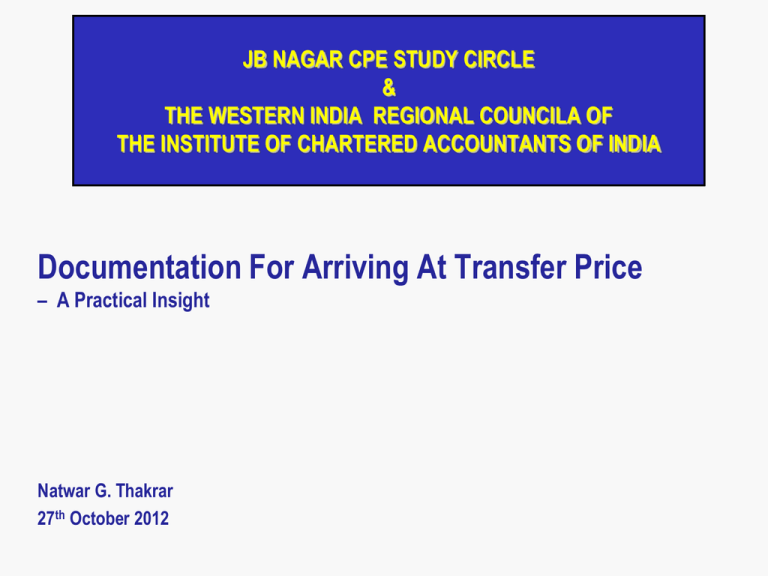
JB NAGAR CPE STUDY CIRCLE & THE WESTERN INDIA REGIONAL COUNCILA OF THE INSTITUTE OF CHARTERED ACCOUNTANTS OF INDIA Documentation For Arriving At Transfer Price – A Practical Insight Natwar G. Thakrar 27th October 2012 Overview 27.10.2012 1. Legislative Overview 2. OECD Guidelines on Documentation 3. Overview of Indian Regulations 4. Documentation Process 5. Documentation in case of Specific Transactions Legislative Overview Legislative Overview Legislation introduced with effect from April 1, 2001 – Built on OECD Guidelines, but with significant deviations Provisions applicable only if: – Their is an international transaction(s) [defined in Sec 92B] ‘between’ – Two or more Associated Enterprises [defined in Sec 92A]. Exceptions – Provisions do not apply in certain cases [Section 92(3)] Deeming provisions [Section 92B(2)] – Transaction between an enterprise and a person (other than an associated enterprise) shall be deemed to be a transaction between two associated enterprises, if there exists a prior agreement or the terms of such a international transaction are in substance determined between one of these entities and the associated enterprise of the other contracting entity. 27.10.2012 Legislative Overview Computation of Arm’s length price by applying the ‘most appropriate method’ (92C read with Rule 10B) out of: – – – – – – Comparable Uncontrolled Price (CUP) Resale Price Method (RPM) Cost Plus Method (CPM) Transaction Net Margin Method (TNMM) Profit Split Method (PSM) Other method as may be prescribed Mandatory contemporaneous documentation requirements (S. 92D) The statute requires information / documents in relation to international transaction to be: kept and maintained in by every person List of documents prescribed in Rule 10D kept and maintained for a prescribed time – 8 years from the end of relevant assessment year furnished within 30 / 60 days of Revenue’s request. Stringent Penal Consequences on Non-compliance coupled with TP adjustments 27.10.2012 What is Documentation? Documentation is essential to justify arm’s length standard as well as to meet the “reasonable cause & good faith” condition to avoid penalties or adjustments. Tested party has to demonstrate with the support of robust documents that it has made reasonable efforts to determine the ALP. Documentation can be determined by review of transfer pricing guidelines by the OECD, the ITA and administrative guidance. Documentation may be in the form of : • Books • Agreements/Contracts • Records • Study Reports • Budgets • Plans & Projections • Cost Records • Analyses • Other supporting material which record information. 27.10.2012 OECD Guidelines Documentation- OECD Guidelines Chapter V of OECD Guidelines “ Documentation obligations may be affected by rules governing burden of proof in the relevant jurisdiction.” “without adequate information the tax administration would not be able to examine the case properly.” Documentation should be “………based upon information reasonably available at the time of the determination…..before the pricing is established” OECD Guidelines state “……… the taxpayer must take into consideration that adequate record-keeping practices and the voluntary production of documents can improve the persuasiveness of its approach to transfer pricing. 27.10.2012 Documentation- OECD Guidelines • Transfer Pricing Analysis shall be done before establishment of transfer prices. • Review & revision of existing TP analysis and documentation, if conditions change. • Standard of analysis and documentation should be from a prudent businessmen point of view. • Written materials preferred to justify arm’ length pricing and production of same in the course of examination. • Information / records not in possession of taxpayer shall not be required. • Use of Exchange of Information Article by Tax Administration. • Limitation on post transaction documents. • Requirement for concurrent information only. • Confidentiality of information furnished. 27.10.2012 Documentation- OECD Guidelines • Required information to be decided on facts and circumstances of each case. • Common features of Transfer Pricing Analysis • • • • • • • • Details of the Associated Enterprise Nature and terms of transaction Basis on which transaction is priced Functions performed, assets used and risks assumed. Information derived from independent enterprises/transactions. Economic conditions and property involved in transaction How the product/services involved in transaction flow among AEs. Details of external / internal comparable uncontrolled transactions. 27.10.2012 Documentation- OECD Guidelines • • • • • • • • Information related to AEs. Information on Pricing Information on Special Circumstances Information on management strategies and type of business. General Commercial or Industry Condition affecting taxpayer. Functional Analysis. • Functions Performed • • Risks Assumed Assets Used / Employed. Financial Information Information on transaction negotiation. 27.10.2012 Overview of Indian Regulations What are the Documentation Requirements? Entity related • Ownership structure of Indian entity • Profile of group (AEs) • Business description of Indian entity • Overview of industry Price related Transaction related • Transaction terms • Agreements • Functional analysis (functions, assets and risks) • Invoices • Economic analysis (method selection, comparable benchmarking) • Pricing related correspondence (letters, emails etc) • Forecasts, budgets, strategies, estimates • Record of uncontrolled transactions taken for Comparability Analysis Other Supporting Documents [Rule 10 D(2)] Analysis performed to evaluate comparability of Uncontrolled transactions with international transactions Methods considered and selection of MAM with explanations Actual working carried out for determination of arm’s length price Assumptions, policies, price negotiations which have critically affected determination of arm’s length price Adjustments, if any & other relevant information 27.10.2012 Statutory Requirement under Rule 10D Particulars Documents Required Organisational Structure • Details of Shares • Profile of the Group • Name , Address, Legal status, ownership linkages & country of tax residence of each of the enterprises in the group Nature of business / industry & Market Condition • Broad Description of the business of the tax payer • Industry background • Business of the AE Controlled Transactions • Nature & terms of international transactions • Details of property transferred/service provided • Quantum & Value of International Transactions 27.10.2012 Statutory Requirement under Rule 10D Particulars Documents Required Background Documents • Record of Economic and Market Analysis • Forecasts, budgets or any other financial estimates Comparability, functional & risk analysis • Record of uncontrolled transactions • Record & evaluation of comparability of transactions • Description of Functions performed, risk assumed and assets employed Selection of TP method • Description of methods considered for determining ALP • Most Appropriate Method selected along with reasons for selection • Record of actual working of ALP • Details of the actual working of comparables w.r.t ALP • Details of differences between comparable data & uncontrolled transaction • Mode of adjusting the factors Application of TP method • Record of actual working of ALP • Details of the actual working of comparables w.r.t ALP • Details of differences between comparable data & uncontrolled transaction & • Mode of adjusting the factors 27.10.2012 Statutory Requirement under Rule 10D Particulars Documents Required Assumptions, •Assumptions , Policies and price negotiations , which have Strategies, Policies critically affected determination of ALP Supporting Information •Official reports , publications, •databases & studies from the government in the country of residence of the AE, or any other country, relevant to international transaction. •Market research studies and technical publications brought out by institutions of national and international repute 27.10.2012 •Correspondence documenting the terms of negotiated between the AE’s. Statutory Documentation Requirements • Law requires information/documents in relation to an international transaction to be – Kept and maintained in prescribed manner by every person [Section 92(D)(1)] – Kept and maintained for prescribed time [Section 92(D)(2)] – Furnished within 30/60 days of Revenue’s request [Section 92(D)(3)] • Penalties Default Penalty Failure to maintain documents 2% of the value of international transaction Failure to furnish documents 2% of the value of international transaction Failure to furnish accountant’s report ` 100,000 27.10.2012 Statutory Documentation Requirements Threshold Limit : • If the aggregate book value of the international transactions < INR 10 million – NO need to maintain the prescribed documentation Period of maintenance of documentation: • The Prescribed information & documentation should be contemporaneous and must be in existence by the specified date – November 30th of the following financial year. • Documentation to be retained for 9 years ( eight years from the end of relevant assessment year) Relaxation of requirements : • If an international transaction has effect on more than one financial year, a fresh documentation need not be maintained separately, unless there is significant change in the : • Nature or terms of the international transactions. • Assumptions made • Any other factor which could influence the transfer price Maintenance of Transfer Pricing Documentation Indian Statute of Limitation – An illustration – Year Ended March 2012 S. No Timeline 1 2 3 4 5 6 7 Compliance 30-Nov-12 Deadline for maintaining documentation, filing tax return and accountant’s report 30-Sept-13 Limitation for initiating a transfer pricing audit by the tax administration 31-Jan-16 Limitation for completion of the transfer pricing audit (scrutiny by the Transfer Pricing Officer) 31-Mar-16 Limitation for completion of tax audit (scrutiny by the Assessment Officer) Relevant Provision Section 139(1) read with Section 92E Proviso to section 143(2)(ii) Section 92CA(3A) read with Second Proviso to Section 153(1) Second Proviso to Section 153(1) 31-Mar-17 Limitation for reassessment (where income Section 149(1)(a) escaping assessment is less than INR 100,000) 31-Mar-19 Limitation for reassessment (where income Section 149(1)(b) escaping assessment is equal to or greater than INR 100,000) 31-Mar-21 Date till which documentation is required Section 92D and Rule 10D(5) to be maintained Documentation Process Key to dos before finalizing Documentation Stage 4 Stage 1 Stage 2 Functional analysis Information gathering Pre-project planning • Preparation of project plan • Interviews • Questionnaires Stage 3 Comparable data / Industry Analysis • Search strategy • Access to local & • Discussions with global database Management • Analysis of • Characterisation internal of each entity comparables • Judicious • Agreement reviews identification of arm’s length range 27.10.2012 Stage 5 Economic Analysis • Understand existing costing mechanism • Determination of billing methodology Issuance of Transfer Pricing Documentation • Consultation with management • Finalization of Transfer pricing documentation FAR Analysis Activities performed An assessment of: • Operations of group companies Pricing Strategy • Their management and ownership characteristics • Economic factors impacting business Risks assumed (Debtors, Currency, Market) 27.10.2012 Assets employed (Infrastructure, Intangibles) What comes out of Functional Analysis ? Criteria for Comparability Understanding of where and how value is added Functional Analysis Appreciation of the potential for change 27.10.2012 Platform for economic analysis Compliance with documentation requirements Functional Analysis Contract Manufacturer Full- Fledged Manufacturer Functions Research & Development Purchasing Manufacturing Assembling and Packaging Warehousing and Logistics Engineering Quality Control Labour Management, Training Marketing Sales & Distributions After Sales Services Risks Business risks Market risks Manufacturing risk Foreign exchange risk Inventory risk Credit risk Research & Development risk Warranty risk Assets Product intangibles Manufacturing intangible (volume) ? ? ? Profit expectation follows functions, risks and assets Expected Profit + High Low _ Contract Manufactu Simple rer (Low) Loss possible FullFledged Manufactu rer Manufacturing + R&D + Regional/global marketing + All risks Integrated (High) Functions/Risks/ Assets Employed Profits Relate to Functions and Risks Each activity or enterprise receives a share of total profits that reflects the contribution of that activity or enterprise to earning those profits. Distributor profit Trademark & technology intangibles Base toll manufacturing fee Service fee Return for assuming operating cost risk Market power Return for assuming long-term volume risk Return for assuming inventory price risk Inventory carrying cost Sourcing fee 27.10.2012 Process know-how Location savings Economic analysis – An illustration Selection of Tested Party Selection Selection of Selection of comparable of “best database companies method” Specific of the tested party Risk and reward matrix FAR Analysis Focus points of economic analysis Geographic location Analysis of group structure Local transfer pricing needs KERT / SPF 27.10.2012 Arm’s length result Contractual Terms Factors Affecting Comparability How risks, benefits and responsibilities are divided? Analyze terms whether written or oral, explicit or implied Independent parties will hold one another to terms and only rarely will modify Less incentive to do so in controlled transaction → therefore examination necessary Analysis to follow the actual conduct of the parties 27.10.2012 Economic Circumstances Factors Affecting Comparability Prices vary across different markets even for same products Essential to identify relevant market(s) related to transaction Whole variety of factors to take into account: Location, size, competitive position, availability of substitute goods/services, level of supply and demand, purchasing power, regulation and local costs, level of market (retail or wholesale), date and time of transactions etc. 27.10.2012 Business Strategies Factors Affecting Comparability • Business strategies may include start up (entering a new market) marketing strategy to increase the market share; Business strategy may sacrifice current profits for higher anticipated profits What happens if anticipated profits are not in fact realized? evaluate position critically to see if strategy is credible: e.g. look for consistent behavior and see who bears costs and is intended to reap rewards would independent enterprise have entered into such a scheme and would it have continued long after anticipated profits have not materialized? 27.10.2012 Documentation in Case of Specific Transactions Royalty payouts Issues relating to Royalty pay-outs: Documentary evidence / analysis to substantiate Royalty: Royalty is widely adopted appropriate mechanism to compensate for use of manufacturing intangible • Copies of license agreement Benchmarking Issues: • Aggregation approach under TNMM – Challenged and general lack of availability of comparables • Transaction specific approach has been adopted by revenue – examine the analysis ‘cost – benefit ‘ • Non acceptance of Foreign Comparables / Databases Possible Solutions on Valuation: • Market approach – Value based on current purchase / sale of such intangible • Income approach – Calculating the present value of future benefits • Cost approach – Replacement cost of similar intangible Is Royalty Payment justified in case of loss situation? 27.10.2012 • Benefits received / receivable by the tax payer and quantification of the benefit • Unique nature of the intangible, market where it is used and strategic advantage achieved • Rights of the taxpayer to receive upgrades . • Comparative profits before and after the use of intangible. • Whether there are any geographic restrictions such as to export based on the licensed technology • Details of patents / intangibles registered by taxpayer in India • Quote of a comparable independent technology recipient for the intangible. • Rates at which the royalty is paid for use of similar intangibles by any other concern / subsidiary of the AE / Group. Management Fees Issues relating to management fee payouts Justification of the following aspects: • Was there service received from Group • Why not from third party • Would there be same payment if rendered by third party • Services rendered by group are not in the nature of stewardship, duplicative services • Services in nature of back-office like accounting / payroll etc., being questioned that while others are off-shoring to India why taxpayer has to receive such service from Group Documentary evidence to substantiate management fees • Business reports • Training manuals • Marketing brochures • Time sheets / logs • Copies of emails • Minutes of meeting confirming receipt of services • HR Schemes • IT network / e-mail systems Challenge: Inadequate comparable data in the public domain Payment justified for services not in the nature of shareholding services, duplicative services and passive association benefits. 27.10.2012 Management Services – Illustrative Model Documentation Documentation requirement specific to certain services Strategic Planning Information Technology Support ◘ Business Reports / Plans ◘ IT Security Policy and Manual; ◘ Trainings ◘ Details of trainings received; ◘ E-mails ◘ E-mail system ◘ Telecon-notes ◘ Intranet ◘ Corporate Governance initiatives ◘ Servers including Remote Servers Accounting and Finance Human Resources ◘ Accounting system ◘ HR Manuals ◘ Accounting manual ◘ Appraisal and Evaluation ◘ Business Reporting system ◘ Welfare Schemes ◘ Trainings ◘ Trainings Sales and Marketing Supply chain Management (‘SCM’) ◘ Details of any marketing strategic inputs ◘ SCM Manual and Policies ◘ Details of sales converted due to marketing assistance ◘ Write-up on inventory management ◘ Brand and Sales Promotion Material ◘ Daily distribution plan ◘ Trainings ◘ Demand forecasting and production scheduling 27.10.2012 Judicial Decisions relating to Documentation , Royalty and Management Fees Case Law Key Contentions of TPO / Taxpayer Ruling M/s Gemplus India Pvt. Ltd. (Taxpayer) [ITA No.352/Bang/200 9] Payments made against Management Services Agreement should be commensurate to the volume and quality of services and such costs should be comparable.Payment terms were independent of the nature or volume of services as the expenses were allocation from the Group and not charged on the basis of the actual services rendered to individual units. Taxpayer has not proved the commensurate benefits received for the service fees paid to the AE and hence TP adjustment upheld. There were no details available on record with respect to the nature of services rendered by the AE to the Taxpayer and, hence, the TPO was justified in holding that the Taxpayer has not proved the commensurate benefits against the payment of service fees to the AE. M/s Auto Ltd Abhishek Industries [ITAT-DEL-TP] In relation to the payment of royalty and technical knowhow, the tax payer contended that since the payment was made in accordance with the agreements approved by regulatory agencies, the question of arm’s length consideration does not arise. The TPO contended that since there was no transfer of technology, the ALP of the transaction was nil and is bundled with the purchase function. 27.10.2012 In light of the present ruling, it would be useful for multinational enterprises with Indian affiliates to review their intra-group arrangements relating to intra-group services for India and assess the need to strengthen the documentation that would help demonstrate compliance with arm’s length principles. The Tribunal observed that commercial expediency is the domain of the tax payer and the revenue cannot arbitrarily reject agreements without cogent reasons. Written agreements which are duly executed by parties based on commercial expediency cannot be disregarded without giving any cogent reasons reliance Cost Contribution Arrangements As per OECD the following information would be relevant and useful : • A list of participants • A list of any other associated enterprises that will be involved with the CCA activity or that are expected to exploit or use the results of the subject activity • The scope of the activities and specific projects covered by the CCA • The duration of the arrangement • The manner in which participants’ proportionate shares of expected benefits are measured, and any projections used in this determination • The anticipated allocation of responsibilities and tasks associated with the CCA activity between participants and other enterprises • The form & value of each participant’s initial contributions, and a detailed description of how the value of initial & ongoing contributions is determined & how accounting principles are applied consistently to all participants in determining expenditure and the value of contributions • The procedures for & consequences of a participant entering or withdrawing from the CCA and the termination of the CCA • Any provisions for balancing payments or for adjusting the terms of the arrangement to reflect changes in economic circumstances 27.10.2012 Sustained Losses Sustained Losses: • When a business strategy back fires – • The taxpayer has to show that the objective of the business strategy at the time of entering was to make profits • The taxpayer had taken sufficient steps to avoid the loss • Documentation must include: • Analysis of business strategy • Comparative studies showing the period in which comparable independent enterprises would have been prepared to endure losses • Comparative studies showing the prices at which independent enterprises dealing at arm’s length would have been prepared to sell in the same or similar circumstances ; • Comparative studies showing the prices at which independent enterprises dealing at arm’s length would have been prepared to buy in the same or similar circumstances. THANK YOU CA Natwar G. Thakrar N. G. Thakrar & Co Chartered Accountants Contact no : +91 22 2201 8184 +91 -98 21021841 Email : natwarthakrar@gmail.com 27.10.2012
